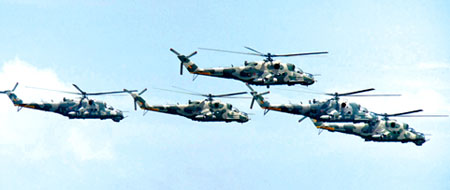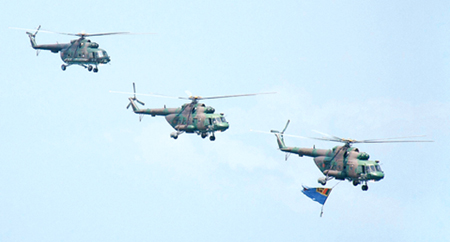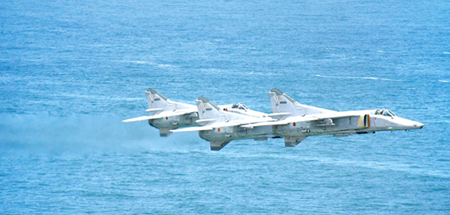Ruling the sky
by Dhaneshi YATAWARA
 Every mission was equally daring for them. Be it either a close air
support, dropping bombs on targets causing maximum attrition to the
enemy or evacuating injured Army personnel, obviously they were clear
targets of the enemy. They, great warriors of the Sri Lanka Air Force
are ready to face any enemy, challenge or threat to save their
motherland; they are not ready to compromise the sovereignty of the
country and for ever their wings will protect the country and its
people. Every mission was equally daring for them. Be it either a close air
support, dropping bombs on targets causing maximum attrition to the
enemy or evacuating injured Army personnel, obviously they were clear
targets of the enemy. They, great warriors of the Sri Lanka Air Force
are ready to face any enemy, challenge or threat to save their
motherland; they are not ready to compromise the sovereignty of the
country and for ever their wings will protect the country and its
people.
Their operations were atypical. The outside world gets to know only
the result - the damage to the enemy. The hardcore fighters behind the
scene and their stories of bravery hardly come into the limelight. What
matters for them is a job well done.
Their duty is to break the LTTE strength and power directly facing
them penetrating into the enemy terrains. There if the mission fails,
ultimate consequence would be nothing else but death as there will be no
escape paths if the aircraft or the pilot gets hit by enemy attacks.
MiGs
The stealthy warrior has many such stories to relate.
One of the daring missions of this fighter squadron was the attempt
to kill LTTE leader Prabhakaran on November 26, 2007. Reliable
intelligence information received by the Sri Lanka Air Force predicted
that several LTTE leaders including Prabhakaran were to attend the
annual celebrations held at a ground in Kilinochchi towards the east of
the A9 road. They were also informed there would be a well fortified
underground bunker as well. Two most experienced MiG pilots were given
the orders by their Commander Group Captain Sajeewa Hendawitharana under
the command from the Director Operations to deal with a senior LTTE
leader who was the crucial target. The two MiG 27s started off from
Katunayake.
 Though the area didn't look heavily populated the pilots were asked
to scoop down to specifically aim at the target as people were seen
moving in and around the area. "The weather over Kilinochchi that day
was quite unfavourable for a pilot. It was with a thick cloud layer,"
one pilot said. Though the area didn't look heavily populated the pilots were asked
to scoop down to specifically aim at the target as people were seen
moving in and around the area. "The weather over Kilinochchi that day
was quite unfavourable for a pilot. It was with a thick cloud layer,"
one pilot said.
After a thorough search the first MiG 27 dived in closer to the
target and no sooner the LTTE started giving heavy resistance. Yet the
pilot managed to drop all four bombs and ascend. "With the heavy firing
from anti aircraft guns the entire sky was covered in thick smoke," the
pilot explained. The bullets of the Anti Air Craft guns explode in the
air after reaching a certain distance creating a scene of fire and smoke
and the pilots get surrounded with this though they try to keep a safe
distance. The second pilot dived amidst the resistance to drop bombs on
the target unfortunately only one bomb was released. Unable to
understand the sudden failure he ascends.
Knowing the consequences of returning to the target when the LTTE
have fully identified these two aircraft, he wanted to return to drop
other threebombs. Until his Commanding Officer gave permission he kept
on requesting as by then it was obvious their real target was present
and understanding the gravity of the situation and trusting on his two
pilots the CO says `ok'. Second pilot dives in to drop bombs but two did
not get released. The two bombs on the right side were released leaving
the two on the left intact. The aircraft was with excess load. And on
top of it his craft cannot be taken out. "I tried giving full power yet
she doesn't ascend," he said. He was just 900m above the ground level
and could have been an easy catch for the LTTE. "I just wanted to save
her (the aircraft) and get out of the chaos so I turned towards the
Kilali lagoon," he said. His senior colleague on the other MiG, stayed
right behind him instructing him and the CO was in continuous contact.
Fuel was in critical condition and an engine nozzle has become
problematic. He was unable to give full power as the craft starts
vibrating. Slow and steadily the two pilots reached Katunayake. "I had
never gone through such failure and landing in the normal manner was not
possible," he said. Landing the MiG 27 safely in this arduous condition
this pilot made history in the SLAF.
Air Force Commander Air Chief Marshal Roshan Goonetilake, Director
Operations A MiG 27 squadron CO and the respective senior officers were
right behind the two pilots directing them, guiding them during this
entire mission. On landing the technical crew found in the post flight
inspection done immediately, a large hole on the right exhaust nozzle
cone - a gun shot. "We wanted to take that risk since we desperately
wanted to destroy the LTTE leadership," he said. "She managed to bring
me to safety though she was injured and after she recovered we started
our duties and we continue to do so," he added with such affection to
the aircraft he is flying.
"Intense battles occurred during the time when the Sri Lanka Army was
regaining Kilinochchi, Pooneryn and most recently Pudukuduirrippu,"
Flight Lieutenant Roshan Perera said explaining about his MiG27
squadron. "If the weather is not favourable keeping the flight
formation, visibility etc becomes difficult. Even under such conditions
we conduct our missions since winning the battle is the topmost
priority," he said.
MI 24
 The battle tank of the Air Force, MI 24 helicopter squadron, played a
crucial role in breaking enemy lines and supporting the rapidly
advancing ground troops. "Providing close air support for the advancing
troops of the Army was our main duty," Wing Commander Sampath
Thuiyakontha the Commanding Officer of the MI 24 helicopter squadron
said explaining the entire mission they carried out in the Wanni
humanitarian Operation. "Proper coordination is crucial in our missions
simply because we reach the closest point in the enemy line and a single
mistake can create havoc," he added. As he said there were no record of
a single day they returned without dozens of bullet holes on the
aircraft. The battle tank of the Air Force, MI 24 helicopter squadron, played a
crucial role in breaking enemy lines and supporting the rapidly
advancing ground troops. "Providing close air support for the advancing
troops of the Army was our main duty," Wing Commander Sampath
Thuiyakontha the Commanding Officer of the MI 24 helicopter squadron
said explaining the entire mission they carried out in the Wanni
humanitarian Operation. "Proper coordination is crucial in our missions
simply because we reach the closest point in the enemy line and a single
mistake can create havoc," he added. As he said there were no record of
a single day they returned without dozens of bullet holes on the
aircraft.
"Our attacks are more effective. We launch 80mm rockets directly on
to the enemy whereas if it is launched from the ground it hits the enemy
indirectly. In addition we have the 30mm gatteline gun fixed in the
front and 23 mm guns as anti personnel guns to directly shoot at the
enemy," he added.
Just imagine LTTE lines being hit by 320, 80mm rockets by a formation
of four MI 24 helicopters. It is an utter devastation to the enemy and
there is no doubt about it.
"Every time it is an intense battle," he said, "We cross the enemy
line and penetrate into their area and when flying low the helicopter is
slow moving and we can be an easy target." There strength is the massive
fire power and launching capability within a short period of time
terrorizing the enemy.
"We carried attacks in all the frontlines during a day and was able
to break positions of the entire enemy line. And everyday, until they
were extremely cornered we continued hitting them severely," he added.
Commenting on the technical assistance Wing Commander Thuiyakontha
explained, the swift actions of the technical staff with Officer
Commanding (Maintenance) Squadron Leader Chandana Liyanage, was the real
strength of the outstanding performance by the MI 24 squadron.
Bell 212
Be it in the middle of the night or during a stormy weather the Bell
212 squadron keep themselves ready for casualty or troop evacuations or
for transportation of troops. "When the soldiers are injured and they
needed to be brought for advanced medical care immediately we just can't
delay. Even seconds may matter," the second in command of the Bell 212
squadron Dhammika said.
Bell 212s are accompanied by the MI24 helicopters during the
evacuation missions when the Army troops get trapped inside enemy
terrain. This is the squadron which was involved in evacuating a Sri
Lanka Army Special Forces Long Range Reconnaissance Patrol from
Oddusudan general area where Major Lalith Jayasinghe was killed during
their mission. At that time the entire area was full of LTTE cadres.
A memorable incident for the squadron is definitely their first
mission carried out on November 22 in 2001 that was led by Captain Sudam
Kaluarachchi to evacuate a seriously injured Sri Lanka Army Commando
team on a heavy rainy day. Captain Kaluarachchi, a brave officer who
carried many such missions suffered a heart stroke, giving a shock to
the entire squadron and since it paralyzed him he is unfortunately no
more with the squadron. "He was a great pilot and a brave officer. He
made the squadron proud," Dhammika added.
F7
Purchased first in 1991 from China the F7 squadron started its
mission mainly as an air interceptor with the F7 BS type of aircraft.
Still this had the capacity of ground attacks. The turning point for the
squadron was the first LTTE air attack on March 26, 2007. The Air Force
was equipped with the F7 GS - the type with air to air interceptor
capabilities. Their basic duty was to destroy enemy aircraft. "This was
a unique situation for our Air Force since nowhere in the world any
other Air Force was facing this type of enemy threat from air," the
Commanding Officer said. Their first success was destroying LTTE
aircraft over Iranapalai. "We have to fly like them in pitch dark and at
low levels even at 500 metres from the ground. It needed great expertise
and fortunately we had pilots of that capacity," he added.
"The F7 has the capability to scan, detect an unidentified aircraft
and to guide it to the nearest air field if it responds positively. If
it does not obey and moves towards a specific target we can launch the
attack," he added.
The F7, on many occasions have supported the Army as well as the Navy
during their operations.
MI 17
Exceeding 5000 flying hours and lifting and transporting more than 71
tons of cargo and over 6000 injured soldiers the MI 17 have done an
outstanding job in their usual silent manner. "Troop movements, casualty
transportation and moving Army's Air Mobile brigades increased immensely
during the recent operations and it was our duty to meet the demand. It
was crucial," the Commanding Officer Squadron Leader Samantha
Petiarambage explained.
To visualize the gravity of their responsibility their first mission
in this Wanni operation would be adequate. In it the squadron had to
move 500 officers and soldiers of the Army's Air Mobile Brigade using
six MI 17 helicopters where one could only carry 30 fully equipped
personnel.
"Professionalism of our pilots, including the capabilities of the
technicians thus we were able to perform our duties throughout the day
without facing any threats from the enemy," he added.
Technical staff
"For the pilot to take off, carryout his mission and return safely
the technicians work around the clock to keep the engines running,"
Squadron Leader Sarada Mawitigama, Officer Commanding (Maintenance) of
the MiG27 squadron said.
Adhering to the norms and conditions of maintaining and servicing an
aircraft, which are of the international level, meeting the demand from
the need of the hour is no easy task. "At times to repair a damaged
aircraft we work 3-4 days continuously to bring the aircraft back to
duty," he said.
"It is not just the technical knowledge that matters to our SLAF
technical crews. We need high versatility and innovative thinking to use
the best out of the Aircraft we have," Sq. Ldr. Mawitigama added. The
technical staff keeps the aircraft ready for missions. It needs
continuous work from these people as during tight operations the Air
Force will only get emergency calls where the pilot has to move in a few
minutes and the time left for the technicians is counted in seconds.
Proper guidance
With the vision of a great leader the Air Force grew in leaps and
bounds. It is the innovative and correct thinking of the Commander of
the Air Force Air Chief Marshal Roshan Goonetilake that made the SLAF
run in this momentum.
Speaking to the average airmen up to the high ranked officer this is
obvious. They simply follow their leader. And for them protecting the
motherland is their priority forever.
|

